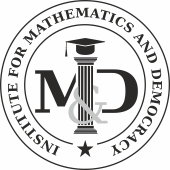2020 Summer research in voting methods through abstract algebra
Wellesley College summer research students (Annette Belleman ‘23, Helen Chen ‘23, Tantan Dai ‘22, Guadalupe Portillo Deras ‘21, and Jingmiao Zhao ‘23) started the project by exploring various voting techniques, but mainly focused on the behaviors of positional counting (Borda Count) and pairwise ranking (Condorcet) methods. Additionally, they studied the peculiarities that arise in voting theory specifically using the two voting techniques mentioned above. They used linear algebra, group theory, and representation theory to study the possible outcome profiles of elections with n candidates. Their work primarily consisted of three different projects: counting the inconsistencies that arise between Borda Count and Condorcet results, the decomposition of profiles with n candidates in an election, and the results of young tableaux multiplication. Each of the projects is explained below.
Incompatibilities and Paradoxical Cases in Voting Theory
The work of Daugherty (An Algebraic Approach to Voting Theory, 2005) has shown that different voting methods yield different winners. Her work has inspired us to explore the cases in which two voting methods, positional tally and pairwise comparison, generate conflicting voting results. We defined this difference as an incompatibility. In this project, we studied ways to calculate the number of incompatibilities by using methods such as permutation matrices, combinatorics, and linear inequalities to show how incompatibilities can be constructed. Calculations were performed in Python. We also explored the Condorcet paradox, i.e. that social preferences can be cyclic even when the individual choices are not cyclic. By applying combinatorial methods, we studied various patterns exhibited by Condorcet paradoxes when there are three candidates. In future work, we plan to tackle the combinatorics of Condorcet paradoxes and incompatibility in the n-candidate model.
Voting Theory
Saari and Daugherty showed how ranked voter profiles can be treated as a module over a permutation group ring. The module can be decomposed for fully ranked data into the kernel, basic, Condorcet, and reversal submodules that correspond to different outcome profiles under positional and pairwise tallies. We studied the decomposition of a fully ranked profile space for n=4 candidates, extend it to the general case of n candidates, and study the relationship between the various subspaces. Further study would extend results to partially ranked data with different shapes of tableaux to understand the subspaces of the profile spaces associated with those shapes.
Young Tableau Multiplication: Quantifying the difference between two tableaux
Fulton (1997) explained how two Young tableaux can be multiplied. This multiplication, which is associative but not obviously so, gives the collection of tableaux a monoid structure. By making small entry changes to either the multiplicand or the multiplier, the shape of the product of the Young tableaux can change drastically. In this project, we analyzed how the shape and entries of tableaux can affect the shape of their product. We could quantify differences in tableaux with a distance formula that gives the set of tableaux an additional structure as a pseudometric space. By numerically measuring the distance between two tableaux with similar factors, one can define the notion of continuity or chaotic behavior of maps. Additionally, the notion of distance between products of tableaux can be further explored in the higher-dimensional context, which we discussed towards the end of the project.



